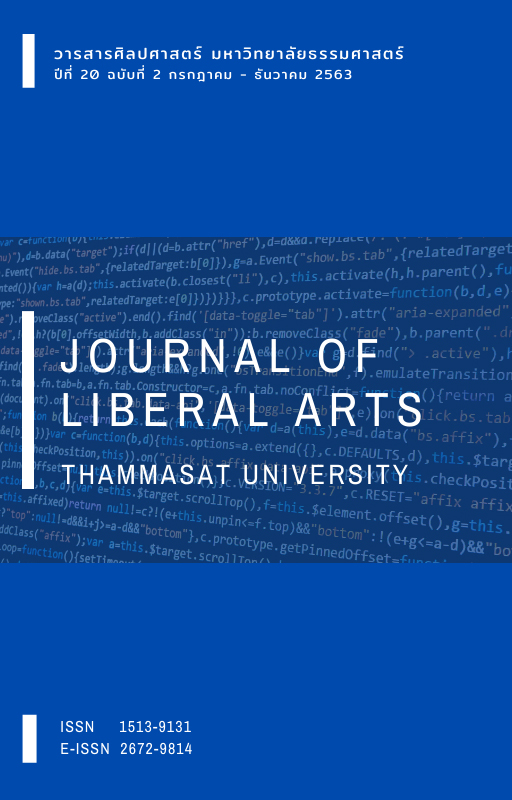Exploring Scenes of “the English Urban Renaissance” in Tobias Smollett’s The Expedition of Humphry Clinker
Main Article Content
บทคัดย่อ
Tobias Smollett’s The Expedition of Humphry Clinker (1771) charts the expedition of Mr. Mathew Bramble and his entourage through English cities and towns. Literary critics have remarked upon the negative portrayal of the English cities and towns in this novel by looking at Mr. Bramble’s dyspeptic view and the bucolic representation of Mr. Dennison’s life at the end of the work. By contextualizing this novel in the socio-cultural history of eighteenth-century England, especially the latter part of the century, this paper aims to illustrate the scenes of “the English Urban Renaissance.” Liddy’s perspective on the city of the late century and certain scenes which represent what this paper calls the triumph of the English Urban Renaissance are the focus of this paper. It also aims to show that the beautiful bucolic world portrayed at the end of the novel is made possible through help from the city.
Downloads
Article Details
เอกสารอ้างอิง
Avison, C. (1775). An essay on musical expression: By Charles Avison, ... With alterations and large additions. To which is added, a letter to the author, concerning the music of the ancients, ... Likewise, Mr. Avison's Reply to the author of Remarks on the Essay on musical expression. In a letter from Mr. Avison, to his friend in London. Eighteenth Century Collections Online. Online text retrieved from https://quod.lib.umich.edu/e/ecco/004865013.0001.000/1:4?rgn=div1;view=fulltext.
Borsay, P. (1989). The English urban renaissance: Culture and society in the provincial town 1660–1770. Clarendon.
Borsay, P. (2002). Urban life and culture. In H. T. Dickenson (Ed.), A companion to eighteenth-century Britain. Blackwell.
Burr, T. B. (1766). The history of Tunbridge Wells. The London magazine, or, Gentleman's monthly intelligencer 35. Printed for R. Baldwin
Cole, J. (1825). Scarborough guide. J. Cole.
Corfield, P. J. (2012). Vauxhall: Sex and entertainment: London's pioneering urban pleasure garden. History & Social Action Publication.
Defoe, D. (1724–1727) (1962). A tour thro’ the whole island of Great Britain. J. M. Dent and Sons.
Duncan, J. L. (1968). The rural ideal in eighteenth-century fiction. Studies in English Literature, 1500–1900, 517–535. https://doi.org/10.2307/449617
Fielding, H. (1751). An enquiry into the causes of the late increase of robbers (2nd ed.). A. Miller. https://doi.org/10.1093/oseo/instance.00051706
Gassman, B. (1974). “Humphry Clinker” and the Two Kingdom of George III. Criticism, 16(2), 95–108.
Hutton, W. (2009). An history of Birmingham. BiblioBazaar. (Original work published 1783)
Knapp, L. M. (2009). Introduction. The expedition of Humphry Clinker. By Tobias Smollett. Oxford University Press.
Krishnan, R. S. (1988) “The vortex of the tumult”: Order and disorder in Humphry Clinker. Studies in Scottish Literature, 23(1), 239–253.
Lane, M. (2007). Jane Austen and Regency Bath. D. Allison.
Lewis, J. (2009). Tobias Smollett. Faber and Faber.
Markidou, V. (2010). Gender and space in Tobias Smollett's "The expedition of Humphry Clinker". Critical Survey, 22(1), 58–73. https://doi.org/10.3167/cs.2010.220104
Morris, R. (1755). Select architecture: being regular designs of plans and elevations well suited to both town and country: in which the magnificence and beauty, the purity and simplicity of designing, for every species of that noble art, is accurately treated, and with great variety exemplified, from the plain town-house to the stately hotel, and in the country from the genteel and convenient farm-house to the parochial church : with suitable embellishments : also bridges, baths, summer-houses, & c. ... : illustrated with fifty copper plates, quarto. Robert Sayer.
Penrose, J., Mitchell, B., & Penrose, H. (1983). Letters from Bath 1766–1767. Alan Sutton.
Porter, R. (2000). London: A social history. Penguin Books.
Smollett, T. (2009). The expedition of Humphry Clinker. Lewis M. Knapp (Ed.). Oxford University Press.
Smollett, T., & Noyes, E. S. (1926). The letters of Tobias Smollett, M.D. Harvard University Press.
Sullivan, C. R. (2004). Enacting the Scottish Enlightenment: Tobias Smollett's expedition of Humphry Clinker. Journal of the Historical Society, 4(4), 415–445. https://doi.org/10.1111/j.1529-921X.2004.00110.x
Sweet, R. (1999). The English town 1680–1840: Government, society and culture. Longman.
Vickery, A. (Guest). (30 September 2004). In our time: Politeness [radio program]. In Simon Tillotson (Producer), London: BBC 4 Radio.
Williams, R. (1975). The country and the city. Oxford University Press.
Wood, J. (1765). A description of Bath, vol.2 (2nd ed.). Printed for W. Bathoe.


